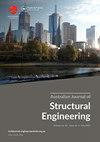桥梁无缝伸缩缝沥青粘结剂流变特性研究
IF 1.3
Q4 ENGINEERING, CIVIL
Australian Journal of Structural Engineering
Pub Date : 2021-01-02
DOI:10.1080/13287982.2020.1862973
引用次数: 2
摘要
无缝伸缩缝作为一种新型的桥梁伸缩缝,以其良好的整体性和行驶舒适性受到了广泛的关注。为了满足变形和道路使用的双重要求,无缝伸缩缝用沥青粘结剂的高温稳定性和低温抗裂性尤为重要。本研究利用动态剪切流变仪对桥梁无缝伸缩缝沥青粘结剂Matrix 502和Colas老化前后进行了温度扫描试验、高温蠕变试验和低温应力松弛试验。试验结果分析表明,两种沥青均具有优异的应力松弛能力和抗高温变形能力。性能较好的改性沥青煤的最大应力松弛量为83%,短期老化后的永久变形量仅为0.48%。此外,根据瑞士联邦公路局无缝伸缩缝道路指南和美国公路战略研究计划,对桥梁无缝伸缩缝使用的沥青粘结剂的技术指标进行了审查,重点是开发具有成本效益的无缝伸缩缝沥青混合料。本文章由计算机程序翻译,如有差异,请以英文原文为准。
Study on rheological properties of asphalt binders for seamless expansion joints of bridges
ABSTRACT The seamless expansion joint has received considerable attention as a new type of bridge expansion joint owing to its good integrity and driving comfort. To satisfy the requirements of both deformation and road use, the high-temperature stability and low-temperature crack resistance of the asphalt binder for the seamless expansion joint are particularly important. In this study, a temperature scanning test, high-temperature creep test, and low-temperature stress relaxation test of Matrix 502 and Colas, as the asphalt binders in the seamless expansion joints of bridges, were performed before and after ageing using a dynamic shear rheometer. An analysis of the test results revealed that both asphalts had an outstanding stress-relaxation ability and resistance to high-temperature deformation. The maximum stress relaxation of modified asphalt coals with good performance was 83%, and the permanent deformation after short-term ageing was only 0.48%. Additionally, the technical indicators according to the Swiss Federal Road Office for seamless expansion joint road guidelines and the United States Strategic Highway Research Program applicable to the asphalt binder used in the seamless expansion joint of bridges were examined with focus on the development of cost-effective bituminous mixtures for seamless expansion joints.
求助全文
通过发布文献求助,成功后即可免费获取论文全文。
去求助
来源期刊

Australian Journal of Structural Engineering
ENGINEERING, CIVIL-
CiteScore
2.50
自引率
0.00%
发文量
31
期刊介绍:
The Australian Journal of Structural Engineering (AJSE) is published under the auspices of the Structural College Board of Engineers Australia. It fulfils part of the Board''s mission for Continuing Professional Development. The journal also offers a means for exchange and interaction of scientific and professional issues and technical developments. The journal is open to members and non-members of Engineers Australia. Original papers on research and development (Technical Papers) and professional matters and achievements (Professional Papers) in all areas relevant to the science, art and practice of structural engineering are considered for possible publication. All papers and technical notes are peer-reviewed. The fundamental criterion for acceptance for publication is the intellectual and professional value of the contribution. Occasionally, papers previously published in essentially the same form elsewhere may be considered for publication. In this case acknowledgement to prior publication must be included in a footnote on page one of the manuscript. These papers are peer-reviewed as new submissions. The length of acceptable contributions typically should not exceed 4,000 to 5,000 word equivalents. Longer manuscripts may be considered at the discretion of the Editor. Technical Notes typically should not exceed about 1,000 word equivalents. Discussions on a Paper or Note published in the AJSE are welcomed. Discussions must address significant matters related to the content of a Paper or Technical Note and may include supplementary and critical comments and questions regarding content.
 求助内容:
求助内容: 应助结果提醒方式:
应助结果提醒方式:


